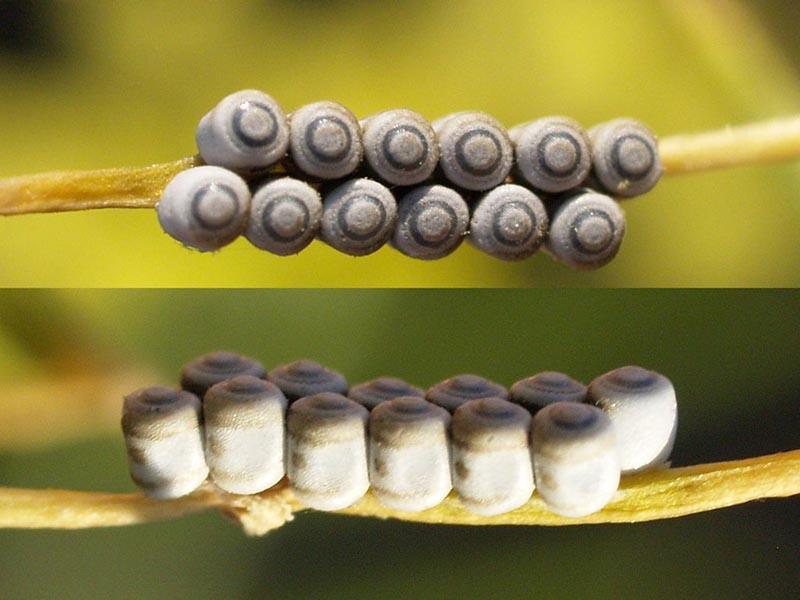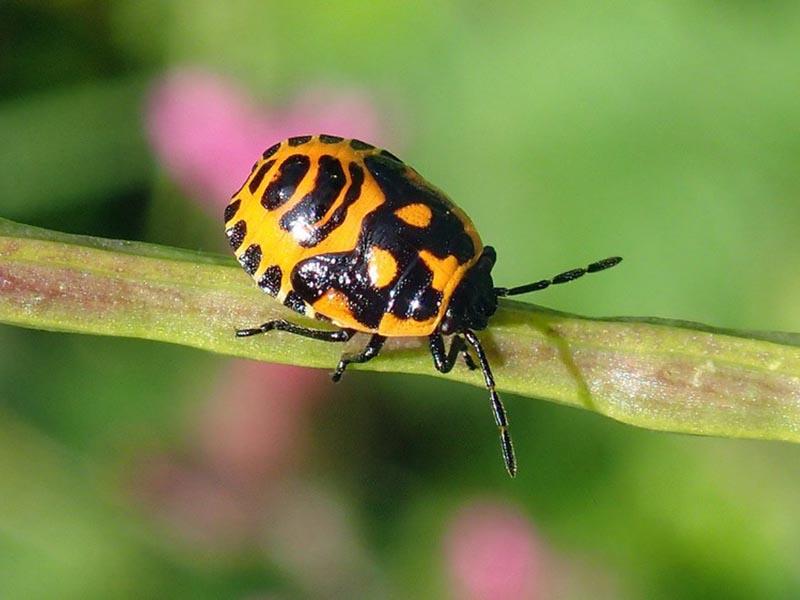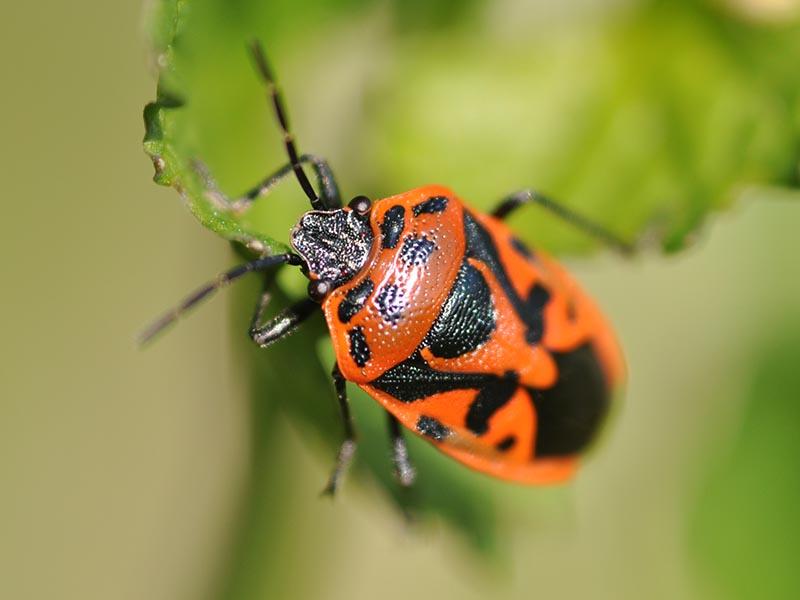
Осталось дело за малым – понять, что случилось. Я изучила много информации, по признакам похоже, что урожай подтачивали крестоцветные клопы. Это их основной источник пищи, видимо, насекомых стало много, т. к. спасти растения я не успела. В следующем году хочу подготовиться лучше: начиная с почвы и заканчивая обработкой. Для себя определила самые важные вопросы: как распознать таких клопов, почему они вредны, что нужно делать для защиты урожая. Помогите разобраться, пожалуйста, по всем пунктам. Заранее благодарю. Арина.
The author of the portal answers the question:
In my material below, you will learn about simple ways to control crucifer bed bugs.
The cruciferous bug: what it looks like and how it reproduces. Close-up photos
Body length of pests varies depending on the species: from 5 to 10 mm. There is a roll on the pronotum. The main difference between these insects is the multicolored coloration. You can see a pattern of dots on a yellow, white or red background. Bed bugs have 3 pairs of limbs, which allows you to distinguish them from spiders (including mites). There is also 1 pair of antennae. They are polysyllabic, as are the paws. The outer covers have a glossy sheen.
Size eggs are smaller than those of the average bedbug of any other species, 0.6-0.8 mm. They are rounded, flattened at the top and bottom, which makes them barrel-shaped. The coloration is green or gray. Upon closer inspection, a cap through which larvae emerge can be seen on one side. Juveniles are imago-like. They are similar to adult pests in many ways, but smaller in size.
Cruciferous bugs in most cases produce only 1 offspring per season.
This is the main peculiarity of pests living in the regions of the middle belt of the country. In the south, representatives of some species promote the emergence of 2-4 generations of insects. A clutch contains 12 eggs (6 in a row). Larvae develop inside shells for 1-2 weeks. Full formation of adults takes 4 weeks. During this time the larvae increase in size to the desired size. In addition, wings appear, which were not present at the initial stage of development.



Peculiarities of adult behavior
The cruciferous bug is active in late spring and early summer, when average daily temperatures are stable and high. The insects lay the most eggs during the hot period. Interestingly, these insects hibernate when the air temperature drops.
To get through the cold spellThe larvae need protection: leaf litter, compost debris, moss, and weeds. Larvae and adults suck the sap on leaves and flowers to get a dose of nutrients. They make a puncture, which leaves yellowish spots on plant tissues.
On cabbage and other cruciferous crops, the insects begin to parasitize in late spring.
Immediately after coming out of hibernation (in mid-spring), bed bugs need food, so they suck the juices out of weeds.

Nooks for eggs and larvae
Insects make a clutch on leaves and stems. But it is not easy to notice it. This is explained by the fact that the eggs are located on the leaves on the back side.
To detect the offspring of the cruciferous bug, you need to inspect the plants.
It is recommended to turn the leaves. This is a time-consuming task, because the entire above-ground part of the plants must be inspected all over the site.

Types of cruciferous bugs
There are about 30 species of insects of this group. Only half of them are found in Russia. The cruciferous bug of each species differs in appearance.
Cabbage (E. ventralis)
In spite of its name, this pest, besides cabbage, also prefers other crops: rutabaga, radish, radish, and turnip. It is also satisfied with wild plants of this group. The pest is about 10 mm long and has a red-black coloration. Embryos develop inside eggs for 6-12 days.
The female can lay up to 300 eggs.
Bed bugs that live in southern regions, make the second frame in mid-summer, closer to August.

Mustard (E. ornata)
This pest can be considered a universal pest. It destroys different cruciferous crops (cabbage, radish, radish) with equal appetite, but is also not indifferent to oil-bearing plants: mustard, rye, rapeseed.
Interestingly, the mustard bug is more often found on wild plants than on cultivated plants.
Its life style and developmental period are the same as those of its cabbage counterpart. The insect differs in coloration: it has a convex pronotum of black color.

Rapeseed (Eurydema oleracea)
This pest is a member of the shield family. It prefers to destroy rape and cabbage, but also other cruciferous crops. The pattern on the abdomen is interesting: light spots (yellowish, reddish) on a dark background (blue or green).
The bug of this species is found in Europe, Asia, but it is not found in northern regions.
This indicates that the pest is heat-loving.

Northern cruciferous bug
Other names: northern eurydema, red cabbage bug. It is referred to the Shieldworts. It is found in the Far East of Russia, but not in the northernmost regions. In addition, it lives in the forest-steppe zone and steppe. Its body length is less than that of its fellows of other species, about 8 mm. The pronotum is spotted. The coloration is almost the same as that of the other species: black, deep blue, yellow, red - these shades are combined (darker with lighter ones).

Siberian bedbug
Such pests also have bright outer covers. The Siberian bug has 4-6 dark-colored spots on the pronotum, sometimes they form 2 spots. There are light-colored stripes along the edges of the shield.
Insects of this species affect wild and cultivated varieties of cruciferous crops.

Central Asian cabbage bug
In appearance, these pests do not differ from their Siberian counterparts. The coloring of the outer covers is in black-yellow, black-red colors. Black and white bed bugs are also found. They live in Central Asian countries. Food habits: rape, cabbage, mustard. Otherwise, the peculiarities of pests of this and other species are similar.

Agricultural damage of the cruciferous bug
The main danger lies in the destruction of plantings of various crops. Bed bugs injure plant tissues, and together with saliva they inject an enzyme that helps accelerate the death of cabbage, rapeseed, mustard, etc. After the insects get a portion of the plant juice, the damaged area turns yellow, then deforms.
If pests injure the parts of plants that are responsible for growth, there is an inhibition of plant development. This leads to lower yields. The appearance of cruciferous crops also deteriorates noticeably: underdevelopment of the ground part, flowers and fruit ovaries fall off.
If plants are heavily infested, it is impossible to save them because larvae (especially in southern regions) and adults destroy them quickly enough.
When insects damage the leaves, at the same time the structure of the whole ground part is disturbed. If you manage to grow such a cabbage, it will still rot over time. In this case, a specific smell appears and the surface is covered with mucus.

What control measures to use to protect against cruciferous bugs
The insects produce numerous offspring, and some produce up to 4 generations per season. This leads to a rapid infestation of the entire vegetable garden.
The best way to fight is to use a combined method.
In this case, several different types of remedies are used at once or alternately. They differ in effectiveness. But the complex method of treating the site smoothes out the disadvantages of each of them and shows the advantages.

Folk remedies
Such methods are most often used to create unacceptable conditions for insects.
They discourage a strong odor, but do not kill the pests.
If cruciferous bed bugs have appeared, herbal and soap-based control measures are used when insects are still scarce. Effective remedies:
- Take 300 grams of crushed soap, add it to 1 bucket of water, when the chips dissolve, spray the affected plants with the solution;
- use garlic infusion: take 1 kg, crush, pour water (5 liters), after 4 hours should be boiled over low heat for 3 hours, the finished broth should be filtered, diluted with water before use at a ratio of 1:1.


Grandmother's ways
Some remedies have been used year after year for many decades. They were used even by our ancestors, as they became convinced of the effectiveness of such methods. Effective ancient recipes:
- wormwood and tansy are placed around the plot, the smell of these plants is not tolerated by cruciferous bugs, and the development of cabbage and other crops it does not interfere in any way;
- a mixture of sand and tobacco, to prepare the agent take components in equal proportions, it is scattered on the site before the period of activity of insects - in late spring, subsequently it is recommended to repeat the procedure every 2 weeks.

Use of chemicals
Preparations based insecticides are used when the area is heavily infested, because the poisons are highly effective. Spray funds of this species is necessary 2 times just before the adults will make a clutch of eggs: in late spring and mid-summer.
And it is important to spray insecticides no later than 30 days before harvest.
The treatment is carried out under a number of conditions:
- The weather is overcast, not rainy;
- no wind;
- Protective equipment is used: mask, goggles, gloves, closed clothes and shoes, headscarf.
Examples of preparations that are used at the site:
- Carbofos;
- Actara;
- Actellic;
- Belofos;
- Angio.


Agrotechnical measures
If one chooses a method to control cruciferous bugs, it is possible to create unsuitable conditions for them at the planting stage:
- Follow the rules of crop rotation, with a bed of cabbage or other cruciferous crops annually change places with other plantings;
- for planting choose early varieties, bed bugs are not very fond of such plants because of the specific taste of green mass, so they will bypass them;
- cover the seedlings with plastic containers until they get stronger;
- In spring it is necessary to weed cruciferous weeds (shepherd's purse, bitterroot, field broom, etc.) in time, then the bed bugs awakened after hibernation will have nowhere to parasitize, they will go to other areas;
- plant a pest repellent grass - clopogon - on the plot.

Wintering
Another control measure is to kill the pests while they are in diapause. Such a phase comes when it gets colder. To survive the winter, insects seek shelter - in the substrate of old leaves, weeds. If no one has removed plant debris, this should be done in winter.
Insects will be removed from the site along with the substrate.
This method is a combined option when waiting until winter to perform mechanical collection of pests on the plot and surrounding areas. However, it is not always possible to remove all individuals, some are carefully hidden, but in the spring it is easier to kill a small number of bed bugs than an entire colony.

Help from natural enemies
For crucifers pests there is another threat - the appearance of insects of certain species. For example, bedbug eggs are harmed by trissolcus. The phasian fly destroys sexually mature specimens. Man cannot control the number of these pests, so in this case you have to rely on the mercy of nature.
Purposely destroy natural enemies The cruciferous bug should not be used precisely because of the likely benefit to the plantation, and thus to humans as well.

Preventive resettlement measures
People use a variety of methods to reduce the number of insects on cruciferous plants. This helps to prevent bed bugs from settling in the area.
Insects become fewer or they leave the area altogether.
Preventive measures that are characterized by effectiveness:
- in the fall after the harvest and in the spring immediately after the first wave of warming performs digging of the ground;
- Seedlings are protected in different ways: agrovolok, plastic bottles (they are pre-cut into 2 parts, broadly applied);
- before the onset of winter remove organic debris from the site;
- special traps are placed on the site, the principle of their work: the devices are connected to a voltage source, emit light, when the pests crawl up, they are killed by the discharge of electricity.
Video overview of cruciferous bug, the main differences, how to protect the garden
Vegetable gardeners' reviews

Expert advice

- After collection, the leaf liner and plant debris should be dried in a closed container and then burned, this will help prevent the reappearance of bed bugs;
- when insects appear in the area after hibernation, they do not immediately look for cruciferous crops, but infest the weeds, so after winter there should be no leafy substrate (where pests may have remained from the fall), or young plants.

Conclusion
Cruciferous pests inhabit areas where they find suitable food for themselves. Cabbage, radish, and radish are used for this purpose. But bugs are not limited to such plants, they also destroy other cruciferous crops. Some of the other pests are more common: rapeseed, northern, Siberian and some others. To get them out of the plot, you need to learn more about these insects:
- The body length is 5-10 mm and the body shape is oval. A bright coloration can be seen on the pronotum, with one of the colors being dark (black, blue) and the other being light (red, white, yellow).
- They cause damage to plants: they suck out the sap, leaving yellow spots all over the leaf. The insects destroy not only the green part, but also the flowers.
- Regular feeding of bugs on cruciferous plants results in deformed shoots and reduced yields. Due to the introduction of a special enzyme into the tissues, the properties of fruits deteriorate. Chemical and folk remedies, as well as agrotechnical methods are used to destroy them.

